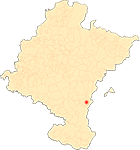The monastery of La Oliva
By Carlos J. Martínez Álava
Faculty & Advisory Board
The monastic quarters are organised around a large open space which, in addition to communicating with each other, serves as a place of meditation and a processional space. Following the work of Wayside Cross, the chapter wing began in the early stages of construction. Perpendicular to it, and parallel to the axis of the church, the refectory wing was then erected. The picture closed with the wing of the chapel and the laity, the last to be built. The cloister was only accessible to monks, never to laymen or converts who lived in the western part of the cloister. From their refectory-dormitory, a corridor led to the church, where the westernmost sections were reserved for them.
At La Oliva, in addition to the three traditional pandas, the foundations of the infirmary wing have been preserved, which from the scriptorium continued eastwards to connect with the chapel of Saint Jesus Christ. We know that this little chapel was consecrated in 1232. This date is important to give us an idea of the chronoconstructive evolution of the work. Around this time, the abbey church was being completed, and the chapter wing was already finished. The refectory wing with the kitchen must also have been well advanced. conference room Later, the large monastic dormitory was to be built above the chapter house and the refectory, and the laymen's wing, with the cilla and the wine cellar.
The definition of the galleries was left until much later. At least as we see them today, as there are traces of earlier supports that testify to the previous presence of galleries, either vaulted or wooden. The eastern wing was the first to be built. The Evreux coats of arms date its construction to between 1330 and 1350, coinciding with the reign of Lope de Gallur (1332-1362). Its tracery coincides with that of the south side of the cloister of Pamplona Cathedral. The rest of the cloister is much later. Despite the structural and aesthetic continuity, we will have to wait until the abbacy of Pedro de Eraso (1468-1502), whose coat of arms appear repeatedly. The tracery was now more varied and complex, combining radiant and flamboyant patterns with others that were fully flamboyant.












